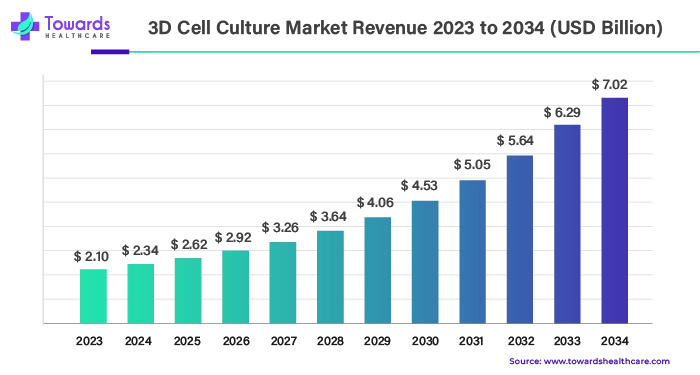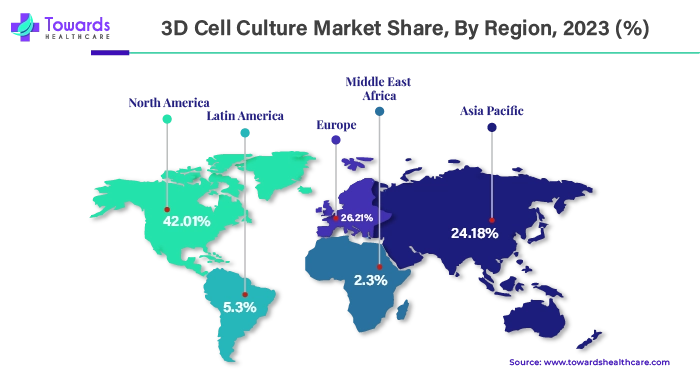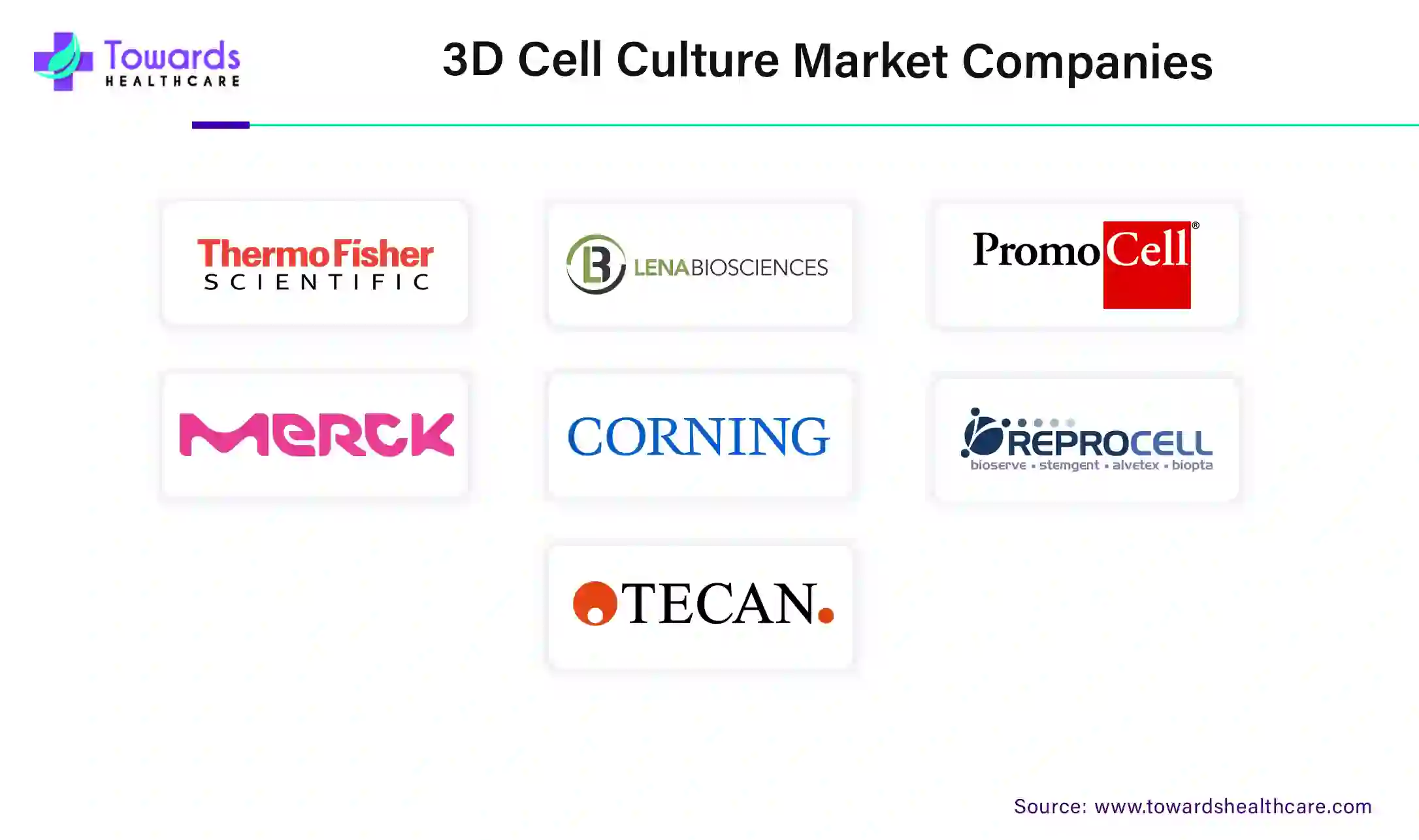April 2025

The global 3D cell culture market was estimated at US$ 2.10 billion in 2023 and is projected to grow to US$ 7.02 billion by 2034, rising at a compound annual growth rate (CAGR) of 11.6% from 2024 to 2034. Growing research in spheroids and organoids is driving the market’s growth.

In a three-dimensional (3D) culturing environment, cells can proliferate and engage with the extracellular framework around them. Due to its obvious benefits in delivering more physiologically relevant information and more predictive data for in vivo studies, three-dimensional (3D) cell culture techniques have attracted growing attention in the fields of tissue engineering and drug development. In order to circumvent extensive and expensive animal testing, cell-based assays have become a crucial component of the drug development process, offering a quick, easy, and affordable alternative.
Because AI technology is developing so quickly, there are currently products available on the market that fully automate cell culture studies. In addition to creating 2D and 3D cellular models, AI-powered software with integrated protocols may also automate the feeding and passaging of cells during their whole trip. Automated methods for effective organoid manufacture, image processing, and application readouts may be efficiently monitored and instructed by machine-learning algorithms. Artificial Intelligence minimizes human error and unpredictability while cutting down on hands-on time in the lab.
For instance,
There are several reasons to switch from animal-based to 3D cell culture models. However, ethical issues with animal models are one of its main drawbacks, regardless of the model's quality. Because it takes a lot of resources to maintain and run an animal facility, animal testing is frequently time-consuming and highly expensive. Techniques without using animals are far less expensive and time-consuming. Since human cells can be used in 3D models, they more accurately depict human physiology.
A few forms of measurement and microscopic analysis can be challenging with 3D cell cultures because of their bigger size than 2D cell cultures. Distributing nutrients throughout the cell culture to where they are needed might be difficult in bigger cultures.
If physicians could use organoid models to produce a variety of cell types from collected stem cells, personalized therapy would become much more accessible. Not only can physicians cultivate tissues and cells suitable for transplantation, but they may also screen a wide variety of drugs for adverse effects before recommending them to patients. These possible changes in the medical industry foreshadow a significant surge in the 3D cell culture market. While research instruments can yield substantial profits when used independently, their implementation in the real world of medical care has the potential to produce enormous sales volumes.
By technology, the scaffold-based segment held the largest share of the 3D cell culture market in 2023. The well-known method of 3D cell culture involves growing cells on structural scaffolds, which are usually made of biopolymers organized in a way that mimics the extracellular matrix (ECM) in animals. Typically, these scaffolds are made to be inserts that fit easily into standard cell culture procedures.
For instance,
By technology, the scaffold-free segment is anticipated to grow at the fastest rate in the 3D cell culture market during the forecast period. Non-adherent cell aggregates known as spheroids are created by the cells self-assembling thanks to scaffold-free approaches. Improved in-vitro cellular models for high-throughput screening are spheroids produced using non-scaffold-based methods, which are more uniform in size and form. One may create spheroids using a variety of platforms, ranging from specific plates to more integrated systems.
By application, the stem cell research & tissue engineering segment held the largest share of the 3D cell culture market in 2023. 3D cell culture has been a popular culture method in recent years. Tissue engineering, regenerative medicine, stem cell research, toxicity testing, medication discovery, and the creation of organoids and assemblies are among its possible uses. Stem cell research has made significant strides by employing 3D cell platforms that replicate the growth and control of cellular signaling in living things.
By application, the cancer research segment is estimated to grow at the fastest rate in the 3D cell culture market during the forecast period. Spheroid and organoid models have made it possible to understand human development, the beginning and progression of disease, and customized medicinal approaches—achievements that may not be possible with animal models. Using 3D culture is one cutting-edge method, particularly when investigating cancers and identifying potential anticancer drugs for them. Spheroids and organoids have been shown to be adaptable in vitro preclinical models and tools for reliable and transferable clinical outcomes when compared to other in vitro methods for anticancer drug screening.

The growing incidence of cancer worldwide, its disproportionate impact on marginalized populations, and the urgent need to address cancer inequities are all highlighted by the IARC estimates. They are founded on the most reliable data sources that each country will have in 2022. 20 million additional cancer cases and 9.7 million cancer-related deaths were projected for 2022. Five years after receiving a cancer diagnosis, 53.5 million individuals were believed to be still living. Throughout their lives, 1 in 5 individuals will get cancer; 1 in 9 men and 1 in 12 women will die from the disease.
By end-use, the biopharmaceutical & pharmaceutical companies segment dominated the 3D cell culture market in 2023. 3D cell culture has various applications that can be used by biopharmaceutical and pharmaceutical companies. One significant usage is drug discovery. The 3D cells can be used to study the impact of various drugs on human cells in 3D structures. 3D cells can also be used to develop personalized medicines, which is highly beneficial for these companies.
By end-use, the academic & research institutes segment is estimated to grow at the fastest rate in the 3D cell culture market during the forecast period. Academic and research institutes conduct various research using animal cells and animals. With the help of 3D cell culture, researchers can conduct experiments on 3D human cells without using animals. Researchers can conduct various research on human cells for vaccines, therapeutics, drugs, the functioning of stem cells, and so on.

By region, North America dominated the 3D cell culture market share by 42.01% in 2023. It is predicted to keep its dominance throughout the projection period due to the large number of pharmaceutical and biotechnology companies that employ 3D culture technology in collaboration with research institutes and clinical laboratories for the development of regenerative medicines as well as drug discovery and development. The growing need for organ transplantation and the R&D efforts aimed at technologically enhanced solutions account for the majority of the rise in demand for 3D culture goods. Healthcare businesses have also started collaborating and sponsoring different research organizations in an effort to speed up the research process.
In the U.S., the Department of Energy (DOE) said that by 2022, biotechnology and biomanufacturing will be used to improve the lives of Americans. New awards totaling about $178 million were announced by the DOE Office of Science to fund research initiatives related to biotechnology and biomanufacturing. In order to assist biotechnology and biomanufacturing in scaling up to a point where biorefineries may be commercialized, the DOE's EERE also upped its efforts, spending a total of $120 million.
Since 2019, there has been a notable increase in the Canadian biotech industry due to both foreign and local investment in the life sciences sector. This rise is a sign of investor confidence in the value of the biotech sector. A total of $25.9 billion in investments have been made in over 175 Canadian companies. Bellus, Inversago Pharma, and Chinook Therapeutics are a few Canadian life science businesses that have recently received funding. While the total number of global acquisitions has declined, 65 investment deals totaling $12 billion were recorded in the Canadian biotech sector in 2023.

By region, Asia Pacific is expected to grow at the fastest rate during the forecast period. Asia Pacific is emerging as the 3D cell culture market with the quickest rate of growth, partly due to the region's rapidly rising burden of infectious and chronic illnesses. Opportunities exist for both existing and emerging market participants since more biotechnology businesses in this region are concentrating on cell research, and the need for cell treatments is developing quickly. The three main 3D cell culture markets in this area to keep an eye on are China, Japan, and India.
China, the nation with the largest population, is aging at a rate never seen before. In 2020, almost 1 in 5 individuals in China were over 60. By 2050, it is expected that this percentage will rise to 1 in 3, or 25% of the global population, who are elderly. 179.9 million older Chinese individuals, or 81.1% of the population, were affected by chronic illnesses nationwide.
Over 90% of persons in Japan who are 75 years of age or older have at least one chronic illness, and around 80% of them have several chronic illnesses. This information comes from a prior survey conducted in the country. The cause of death data from Japan, however, indicates a significant movement away from infectious diseases during and after World War II and toward non-communicable diseases (NCDs), which include heart and cerebrovascular illnesses as well as cancer.
Eric Perreault, CEO of Kiyatec, Inc., was appointed as the new CEO of Kiyatec, Inc., a leading biotechnology company specializing in 3D cell culture technology. He envisions driving the company toward truly revolutionizing cancer care, especially for brain cancer patients, using 3D cell culture technology, ultimately improving patient outcomes.

| Company Name | HiMedia |
| Headquarters | Maharashtra, India, Asia Pacific |
| Recent Development | In June 2024, a renowned biotechnology business in Mumbai, HiMedia Laboratories, announced the opening of its cutting-edge Center of Excellence (CoE) for 3D Cell Culture Laboratory. With regard to HiMedia's dedication to promoting cooperative relationships and scientific research in the fields of 3D cell culture and bioprinting, this facility marks a noteworthy turning point. |
| Company Name | Cell Microsystems |
| Headquarters | North Carolina, U.S., North America |
| Recent Development | In February 2024, the famous German cell biology business OMNI Life Science (OLS) and Cell Microsystems, a leading supplier of cutting-edge instruments for cell biology, are thrilled to announce a strategic cooperation. Through this partnership, life science research in North America will advance significantly as three ground-breaking products—the CERO, CASY, and TIGR—are brought to the US and Canadian markets. In order to produce specific 3D cell culture models, such as stem cells, spheroids, organoids, and even tissues, the CERO 3D is a novel and innovative device that generates an ideal cell culture environment. |
By Technology
By Application
By End Use
By Region
April 2025
April 2025
April 2025
April 2025